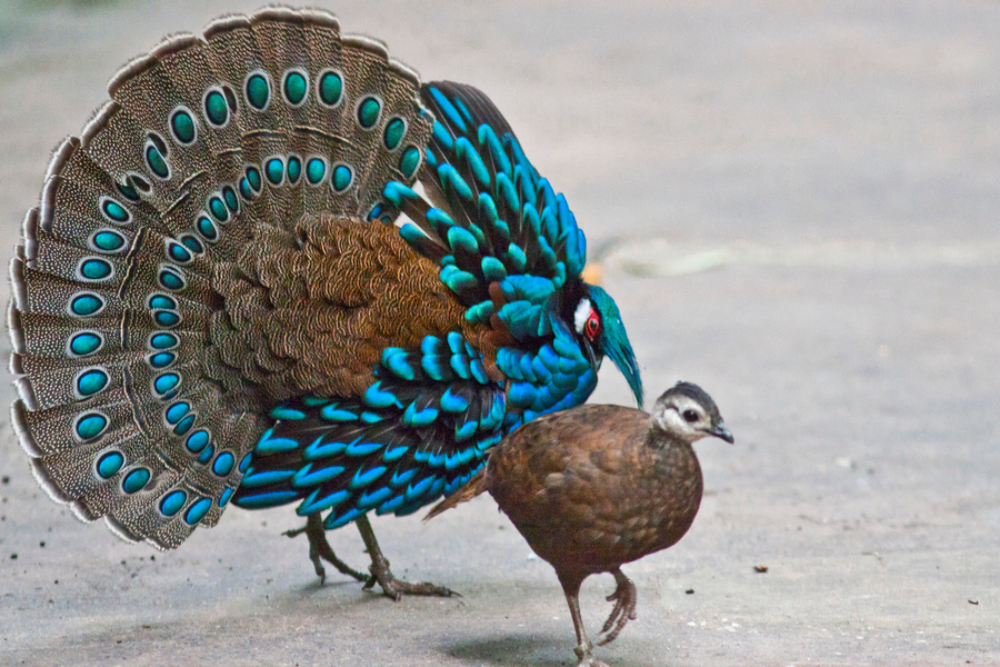The Palawan peacock-pheasant (Polyplectron napoleonis) is one of the most visually stunning and ecologically significant birds in Southeast Asia, particularly within the biodiverse region of the Philippines. Known for its resplendent plumage and striking courtship displays, this bird captivates ornithologists, conservationists, and bird watchers alike. Endemic to the island of Palawan, the peacock-pheasant embodies the unique ecological heritage of the Philippines and serves as a critical indicator of the health of its forest ecosystems.
Taxonomy and Description of Palawan peacock-pheasant
The Palawan peacock-pheasant belongs to the family Phasianidae, which includes other pheasants, partridges, and chickens. Its scientific name, Polyplectron napoleonis, pays homage to Napoleon Bonaparte, likely due to its regal appearance. The male of the species is particularly noted for its iridescent blue and green plumage, adorned with eye-like spots reminiscent of a peacock’s feathers. These ocelli are displayed prominently during courtship rituals, where the male fans his tail and wings to create a dazzling visual spectacle.
Females, while less ornate, exhibit a more subdued brown and mottled appearance, providing camouflage within the dense forest understory. This sexual dimorphism is common among pheasants and serves a crucial role in their reproductive strategy.

Habitat and Distribution
The Palawan peacock-pheasant is endemic to the island of Palawan, located in the western part of the Philippines. The island’s unique geological history and isolation have fostered the development of a rich and diverse ecosystem. The bird primarily inhabits the lowland and foothill forests, thriving in both primary and secondary growth forests. These habitats provide the necessary cover and food resources, such as seeds, fruits, and invertebrates, essential for the species’ survival.
Behavior and Ecology
Palawan peacock-pheasants are ground-dwelling birds, spending much of their time foraging through the forest floor for food. Their diet consists of a variety of seeds, fruits, and small invertebrates, which they uncover by scratching the leaf litter. The birds are known for their secretive and elusive nature, making them a challenge to observe in the wild.
The breeding season of the Palawan peacock-pheasant typically occurs during the dry season, from February to June. Males engage in elaborate courtship displays to attract females. These displays are not only a visual spectacle but also involve vocalizations and intricate movements. The male fans his tail, showcasing the iridescent ocelli, while producing a series of calls and rhythmic dances to entice a mate. Once a female is attracted, the pair engages in copulation, and the female subsequently lays a clutch of one to two eggs.
Conservation Status and Threats
The Palawan peacock-pheasant is currently listed as Vulnerable on the IUCN Red List of Threatened Species. The primary threats to its survival are habitat destruction and fragmentation due to logging, agricultural expansion, and mining activities. Palawan’s forests are under increasing pressure from human encroachment, leading to a decline in suitable habitats for the peacock-pheasant.
Illegal wildlife trade also poses a significant threat. The bird’s striking appearance makes it a target for poachers who capture and sell them as exotic pets. Despite legal protections, enforcement remains challenging, and illegal activities continue to jeopardize the population.
Conservation Efforts for Palawan peacock-pheasant
Efforts to conserve the Palawan peacock-pheasant involve a combination of habitat protection, legal enforcement, and community engagement. Several conservation organizations are actively working to safeguard Palawan’s forests through the establishment of protected areas and the promotion of sustainable land-use practices. Ecotourism initiatives also play a role in conservation by providing economic incentives for local communities to preserve their natural heritage.
Breeding programs in captivity aim to bolster the population and potentially reintroduce individuals into the wild. These programs, however, require careful genetic management to ensure the long-term viability of the species. Public awareness campaigns are essential in reducing demand for illegally traded wildlife and fostering a sense of pride and stewardship among local residents.
Conclusion
The Palawan peacock-pheasant is not only a symbol of the Philippines’ rich biodiversity but also a critical component of its forest ecosystems. Protecting this species requires a multifaceted approach that addresses habitat conservation, legal enforcement, and community involvement. By safeguarding the Palawan peacock-pheasant, we contribute to the broader effort of preserving the unique and irreplaceable biodiversity of the Philippines. Through continued research, conservation action, and global awareness, there is hope for the future of this magnificent bird and the pristine habitats it calls home.









